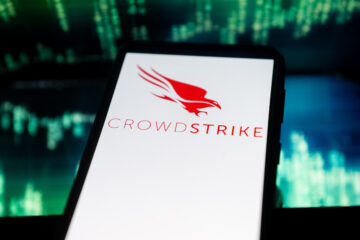Lighting firecrackers are one of the unique cultural keystones that signify the celebration of the Lunar New Year, but during celebrations around the holiday earlier this year in one of the United States’ oldest Chinatowns, things got ugly for something not controlled by a human being.
Amidst the raucous celebration in San Francisco’s historic Chinatown on February 10, a sensor-laden Jaguar I-Pace operated by Google’s (GOOGL) autonomous robotaxi venture Waymo was left burnt to a crisp on city streets after a crowd vandalized and set fire to the vehicle after a firework was left to ignite inside the car.
Michael Vandi, who witnessed the commotion, told Reuters that the incident started when a person jumped onto the hood of the Waymo and broke its windshield. Thirty seconds later, he noted that someone else was cheered on by the crowd when he did the same thing. He emphasized to the news service that people fed off the energy in the crowd, adding that he felt that nothing could have stopped it.
💰💸 Don’t miss the move: SIGN UP for TheStreet’s FREE Daily newsletter 💰💸
“That was when it went wild,” eyewitness Michael Vandi told Reuters while also describing skateboard-wielding people breaking the Jaguar’s glass and others spraying graffiti onto the car.
“There were 2 groups of people. Folks who encourage it — and others who were just shocked & started filming. No one stood up — I mean there wasn’t anything you could do to stand up to dozens of people.”
US President-elect Donald Trump (L) and Tesla and SpaceX CEO Elon Musk watch a fight during UFC 309 at Madison Square Garden in New York, on November 16, 2024.
KENA BETANCUR/Getty Images
Tesla’s robotaxi golden key
Tesla (TSLA) shares were up nearly 7% after the market opening on Monday, November 18, with the stock being boosted by indicators that the “first buddy” relationship between President-elect Donald J. Trump and Elon Musk is bearing fruit that will benefit Tesla’s affairs.
As per a report by Bloomberg, which was first published on the evening of November 17, members of the Trump transition team told the financial publication that the upcoming administration plans to make a federal framework for self-driving vehicles a priority for the next transportation department.
Currently, rules imposed by the National Highway Traffic Safety Association are a significant roadblock for firms intent on deploying large amounts of cars without steering wheels or pedals, such as Tesla’s sleek Cybercab robotaxi, on American roads.
Related: Elon Musk’s Trump appointment may be a bad omen for Tesla
According to people familiar with the Trump team’s plans, the Don intends to stuff the DOT with driven individuals who can help develop legal rules regulating self-driving vehicles at the national level.
Though these rules can benefit established robotaxi institutions like General Motors’ Cruise service or Google’s Waymo, the confident messaging from Tesla bulls like Wedbush’s Dan Ives indicates that this move is intent on benefitting Musk’s EV company-turned-autonomy company.
“This would be a huge step forward in easing US rules for self driving cars and be a significant tailwind for Tesla’s autonomous and AI vision heading into 2025,” Ives wrote in an analyst’s note on the evening of November 17. “Musk’s significant influence in the Trump White House is already having a major influence and ultimately the golden path for Tesla around Cybercabs and autonomous is now within reach with an emboldened Trump/Musk strategic alliance playing out in real time.”
A Waymo autonomous vehicle turning onto Mission Street in San Francisco
Waymo’s vandalism and violence dilemma is caused by Waymo’s wrongs
Although San Francisco Mayor London Breed has decried the Feb. 10 incident as “a dangerous and destructive act of vandalism,” the incident is not a random act of violence brought upon by a bored populace.
Prior incidents involving autonomous robotaxis roaming the city streets have created tension among San Francisco residents, who have been reeling from some very tragic situations caused by the AVs prior to the Lunar New Year fiasco.
Earlier the same month, on February 6, a Waymo similar to the burnt Jaguar struck a cyclist after failing to detect it at the intersection of 17th and Mississippi streets in the Potrero Hill neighborhood of San Francisco. According to Waymo, the cyclist, who was traveling behind a truck, was not detected by the car’s computer as it waited for a large truck to turn onto the four-way stop.
“The cyclist was occluded by the truck and quickly followed behind it, crossing into the Waymo vehicle’s path,” Waymo spokesperson Julia Ilina said. “When they became fully visible, our vehicle applied heavy braking but was not able to avoid the collision.”
The cyclist reported minor injuries.
Related: Waymo’s robotaxi fleet targeted in new federal probe following multiple incidents
Due to incidents like this, Waymo is currently the subject of a Federal probe. On May 13, the NHTSA’s Office of Defects Investigation said it opened an investigation into Waymo after receiving 22 reports of its robotaxis, equipped with the company’s fifth-generation autonomous driving systems, that were “the sole vehicle operated during a collision” or have “exhibited driving behavior that potentially violated traffic safety laws.”
The reported incidents included “collisions with stationary and semi-stationary objects such as gates and chains” and others where Waymos hit parked cars. Other incidents also include a collision that occurred “shortly after” its vehicle’s autonomous driving system “exhibited unexpected behavior” near traffic safety control devices.
More Business of EVs:
Bentley’s first foray into EVs will debut in 2026Trump’s EPA pick Lee Zeldin is the EV industry’s worst nightmareToyota exec slams “impossible” EV mandate amidst political chaos
Tesla’s woes present another challenge
Tesla’s situation is much worse despite not having any Robotaxis on the roads yet.
The autonomous robotaxi is set to use Tesla’s proprietary Full-Self Driving technology, which already has a plethora of scrutiny behind it.
On October 18, the National Highway Traffic Safety Administration (NHTSA) opened a probe into 2.4 million Teslas with the brand’s Full Self-Driving software after four reported collisions, including a fatal crash that was reported to the agency.
According to the agency, it opened the probe after it was made aware of four separate incidents in which Teslas crashed when FSD was engaged during less-than-ideal visual conditions for driving, including sun glare, fog, or airborne dust. In two separate cases, a Tesla vehicle with FSD turned on fatally struck a pedestrian, while another crash involved a reported injury.
Related: Tesla employees shared horror stories behind its illusive product
Additionally, a group of current and former Tesla employees known as Project Rodeo spoke out and shared details about their jobs as Tesla test drivers who test the absolute limits of the brand’s Autopilot and Full Self-Driving software. According to one of its test drivers, the group was often put in situations that could result in a crash.
Despite never having been in a crash with FSD or Autopilot turned on, the test drivers say that they had to explore the limits of their safety nets to keep their jobs. Often, the test drivers got into risky and downright dangerous behavior on public streets with other drivers, including, but not limited to, speeding, crossing double yellow lines, and running stop signs and red lights.
Members of SafeStreetRebel, a group of anonymous anti-car activists, place a cone on a self-driving robotaxi to disable it in San Francisco, California on July 11, 2023.
The anti-robotaxi backlash is serious, and Tesla could be next
Although pranksters have exposed holes in Waymo’s self-driving software system as a joke, active backlash against robotaxis and their deployment in cities like San Francisco is real.
In a statement to Reuters after the Lunar New Year incident involving a San Francisco Waymo back in February, Missy Cummings, the director of the George Mason University Autonomy and Robotics Center and a former adviser to U.S. traffic safety regulators identified the incident as an example of growing, explicit discontent toward self-driving cars and other AI technology.
View the original article to see embedded media.
“We are seeing people reaching a boiling point over tech that they do not want and does not make their lives better,” she said.
Prior to the LNY incident, a group of anti-car activists called SafeStreetRebel gained notoriety after it started placing cones atop Waymos and Cruise vehicles as a protest method against said companies.
“We want to either have [autonomous vehicles] not on the city streets at all or very limited. We see them causing huge disruptions already,” a SafeStreetRebel activist told the San Francisco Standard in July 2023. “It’s like the state has decided that these things are going to be deployed in San Francisco without the consent of the city or the people in it.”
Tesla, Inc., which trades on the NASDAQ as TSLA, is up 7.03% from the opening bell, trading at $343.28 per share.
Related: Veteran fund manager sees world of pain coming for stocks


